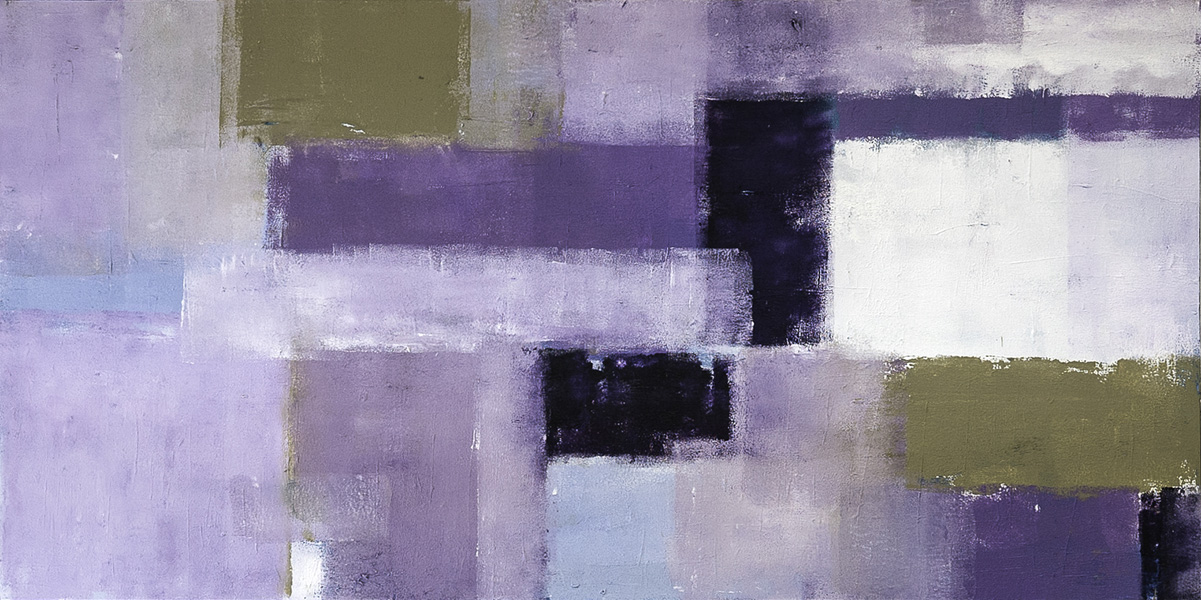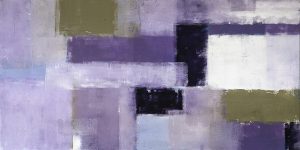In a little corner of the Touchstone Gallery, next to a window looking out onto busy New York Avenue, is the latest collection of paintings from local artist Steve Alderton. Ordered swaths of muted blues and purples hang in silent contrast to the hustle of the streets on the other side of the glass and invite viewers to attempt to piece together the colorful rectangles on canvas that comprise the artwork of “Memoryscapes: Blurry Lines III.”
Since 1995, Steve Alderton’s paintings have been displayed in the Touchstone Gallery in eight solo exhibits. His most recent, “Memoryscapes: Blurry Lines III,” is the final installation of his “Memoryscapes” series, an exploration of Alderton’s concept of nature as a blurred memory. “Memoryscapes: Blurry Lines I” premiered at the Touchstone Gallery in March 2014 and “Memoryscapes: Blurry Lines II” was on display in July 2015.
It was quickly obvious that I was a viewer with absolutely no idea that the rectangles were supposed to be anything other than rectangles. The gallery assistant, upon seeing my tragically confused expression, was kind enough to offer up a press release of Alderton’s latest work. It detailed his childhood in northern Wisconsin, attributing the sceneries the collection draws heavily on to the landscapes of where Alderton was born and raised. The blurred qualities of the artwork and purposeful inability to distinguish between subject and background emphasize the idea that the paintings reflect only pieces of memory from the artist’s past.
As intended, Alderton’s artwork in the “Memoryscapes” collection becomes increasingly abstract and unclear with each additional exhibit in the series. Alderton crafted his own style under the guidance of abstract expressionist painter Helen Covensky in the 1980s, and his interpretation of expressionism is clear in his exploration of memory as a feeling, rather than a concrete idea.The art by no means explores definite concepts; without previous knowledge of the collection, it is nearly impossible to identify what Alderton is expressing in his artwork.
Using sponge rollers and large brushes in “Blurry Lines III,” Alderton removes all sense of the formal landscape structure that characterized his earlier installations. The identifiable natural subjects of his earlier paintings in the series, such as birch trees, lily pads, and black-eyed Susans, are replaced by scenes reminiscent of an aerial view of Midwestern agricultural fields. It’s as if you’re watching the ground rush by through the window of an airplane.The seemingly messy way that Alderton applies paint to his canvas originally appears careless, but the loose brushstrokes are better understood as the animation of a fading recollection. I was troubled by the abstractness of his ideas, as there are no objects or figures to grasp in his work. Detail and form are progressively lost and the content of his artwork is left up to the interpretation of the viewer, often as memories are.
Alderton makes expert use of colors to create the essence of nature without the presence of actual wildlife. Swaths of yellows and greens, though initially off-putting, become reminiscent of the rebirth and renewal of springtime. Muted blues and purples are juxtaposed with flashy pinks and turquoises, symbols of the unpredictability of winter. Large areas of blacks and grays tone down the initial joy of some pieces, often oppressing the brighter colors hidden underneath. These expurgations of life in the paintings are discomforting, almost as if the blacks and grays censored the pieces of memories forgotten.
My favorite piece is “Memoryscapes: Blurry Lines III No. 18,” a 16”x16” canvas of painfully contrasting purples, yellows, and blues. The eye lands on the splotchy square of light purple in the middle of the artwork, and is then immediately drawn to bright yellow to the right and above.The yellow is joyful and a welcomed change to the subdued colors that characterize most of the other pieces. “No. 18” is an outsider in the collection, its patchwork too ordered and intrusive to find solidarity on the gallery walls. But it’s a reminder that memories can be startling and unsettling just as often as they are quiet haziness.
In a perfect world, all three collections in the “Memoryscapes” series would be on display at once. An element of intent is lost in displaying each separately, as it is impossible to understand Alderton’s progressively abstract interpretation of nature without viewing the series in its entirety. A glimpse of how Alderton depicted his two previous “Memoryscapes” installations helped me to understand the current collection and gave the rectangles of color more depth than what I left the gallery understanding about the artwork. However, separation from the two earlier collections does nothing to diminish the legitimacy and independence of the final series installation on its own. Alderton’s work leaves ample room for reflection and interpretation of nostalgia and the past, inviting viewers to enter the gauzy realm of their own memory.





